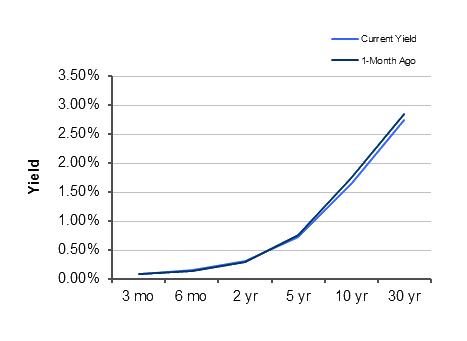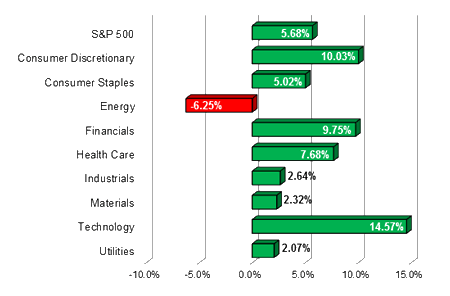
Market Commentary by Scott J. Brown, Ph.D., Chief Economist
 The economic data were mixed, but consistent with a lackluster to moderate pace of growth in the near term. New home sales and the Pending Home Sales Index improved, consistent with a gradual housing recovery. Consumer confidence and consumer sentiment deteriorated, reflecting a worsening of attitudes for households with income over 75,000.
The economic data were mixed, but consistent with a lackluster to moderate pace of growth in the near term. New home sales and the Pending Home Sales Index improved, consistent with a gradual housing recovery. Consumer confidence and consumer sentiment deteriorated, reflecting a worsening of attitudes for households with income over 75,000.
The Supreme Court upheld the Affordable Care Act, with Chief Justice Roberts crossing the political line. ACA would boost costs for some businesses (mid-size and large firms not currently offering healthcare coverage), but isn’t likely to slow the economy appreciably (the fiscal cliff, gasoline prices, and Europe will have substantially greater effects). The Congressional Budget Office projects that ACA will reduce the deficit, but cautions that such forecasts are imprecise.
Pessimism rose ahead of the European summit, but leaders unexpectedly reached an agreement to shore up Spain’s banks and promote growth (which prevents a near-term calamity, but doesn’t solve all of the region’s problems).Next week, with Europe expected to be pushed to the back burner for U.S. investors, the economic data will be more important. The June Employment Report (Friday) will be the most critical – it is the last employment report before the Fed’s August 1 policy decision (where QE3 is expected to be under consideration). Weather and seasonal adjustment issues boosted January and February payrolls, borrowing seasonal strength from April and May (making the last two months look weaker than they really were). Payroll growth is expected to pick up somewhat in June. Still, uncertainty about the election, the fiscal cliff, and Europe could restrain hiring to some extent. Wednesday’s holiday may lead to thinner market activity during the week.
Indices
| Last | Last Week | YTD return % | |
| DJIA | 12602.26 | 12573.6 | 3.15% |
| NASDAQ | 2849.49 | 2859.09 | 9.38% |
| S&P 500 | 1329.04 | 1325.51 | 5.68% |
| MSCI EAFE | 1373.62 | 1396.21 | -2.76% |
| Russell 2000 | 775.89 | 764.83 | 4.72% |
Consumer Money Rates
| Last | 1-year ago | |
| Prime Rate | 3.25 | 3.25 |
| Fed Funds | 0.10 | 0.05 |
| 30-year mortgage | 3.67 | 4.50 |
Currencies
| Last | 1-year ago | |
| Dollars per British Pound | 1.550 | 1.600 |
| Dollars per Euro | 1.243 | 1.436 |
| Japanese Yen per Dollar | 79.390 | 80.960 |
| Canadian Dollars per Dollar | 1.034 | 0.984 |
| Mexican Peso per Dollar | 13.652 | 11.842 |
Commodities
| Last | 1-year ago | |
| Crude Oil | 77.69 | 92.89 |
| Gold | 1552.10 | 1501.58 |
Bond Rates
| Last | 1-month ago | |
| 2-year treasury | 0.31 | 0.29 |
| 10-year treasury | 1.64 | 1.75 |
| 10-year municipal (TEY) | 3.15 | 3.06 |
Treasury Yield Curve – 6/29/2012
S&P Sector Performance (YTD) – 6/29/2012
Economic Calendar
| July 2nd |
— |
Markit Manufacturing PMI (June) ISM Manufacturing Index (June) |
| July 3rd |
— |
Motor Vehicle Sales (June) |
| July 4th |
— |
Independence Day (markets closed) |
| July 5th |
— |
Bank of England Policy Meeting European Central Bank Policy meeting ADP Payroll Estimate (June) ISM Non-Manufacturing Index (June) |
| July 6th |
— |
Employment Report (June) |
| July 11th |
— |
FOM Minutes (June 19th-20th) |
| July 12th |
— |
Trade Balance (May) |
| July 13th |
— |
Producer Price Index (June) |
| July 16th |
— |
Retail Sales (June) |
| August 1st |
— |
Fed Policy Decision (No Bernanke press briefing) |
Important Disclosures
US government bonds and treasury bills are guaranteed by the US government and, if held to maturity, offer a fixed rate of return and guaranteed principal value. US government bonds are issued and guaranteed as to the timely payment of principal and interest by the federal government. Treasury bills are certificates reflecting short-term (less than one year) obligations of the US government.
Commodities trading is generally considered speculative because of the significant potential for investment loss. Markets for commodities are likely to be volatile and there may be sharp price fluctuations even during periods when prices overall are rising. Specific sector investing can be subject to different and greater risks than more diversified investments.
Tax Equiv Muni yields (TEY) assume a 35% tax rate on triple-A rated, tax-exempt insured revenue bonds.
![]() Material prepared by Raymond James for use by its financial advisors.
Material prepared by Raymond James for use by its financial advisors.
The information contained herein has been obtained from sources considered reliable, but we do not guarantee that the foregoing material is accurate or complete. Data source: Bloomberg, as of close of business June 28th, 2012.
©2012 Raymond James Financial Services, Inc. member FINRA / SIPC.




